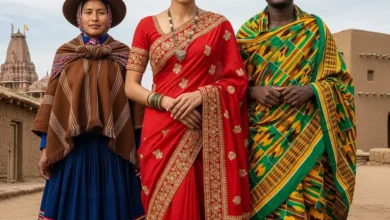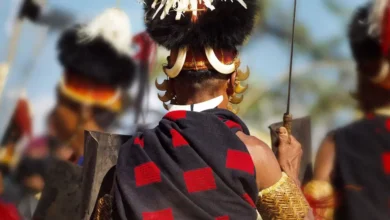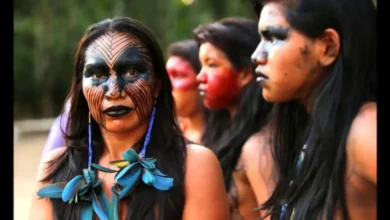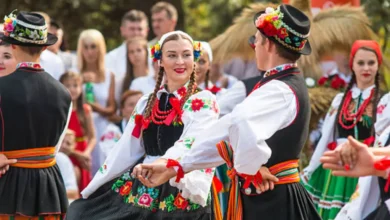Your Clothes Were Never Just Fabric — They Were Armor
That red thread on your wrist?
That eye stitched near your collar?
That spiral twisting down your sleeve?
They weren’t fashion.
They were protection.
For thousands of years — long before locks, alarms, or antivirus software — people stitched, wove, painted, and beaded protective symbols into their clothing.
See also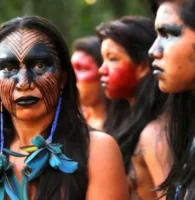 Tribal Identity in Folk Costumes: Ancestral Patterns and Clan Meanings
Tribal Identity in Folk Costumes: Ancestral Patterns and Clan MeaningsNot for likes. Not for trends.
To survive.
To shield against:
- The evil eye
- Jealous whispers
- Lost spirits
- Bad dreams
- Illness
- War
- Grief
This isn’t magic. It’s memory. Intention. Ancestral tech.
See alsoIn this article, you’ll discover:
- 🛡️ What protective symbols in folk wear really are — and why they still work today
- 🌍 Real examples from Slavic, Turkish, Navajo, Berber, Balkan, Celtic, Norse, Egyptian, Native American, Wiccan, and global traditions
- 🔮 The deep spiritual + practical meanings behind each design
- ✂️ How to wear or create them ethically — without stealing sacred traditions
- 🧵 A simple DIY guide to make your own protective symbol (rooted in nature, not appropriation)
- 💬 Strong, respectful Call to Action — because protection should never come at someone else’s cost
Let’s begin — one stitch at a time.
What Are Protective Symbols in Folk Wear? (Plain & Simple)
Protective symbols in folk wear = shapes, colors, patterns, or charms stitched, woven, printed, or pinned onto clothing to guard the wearer from harm — physical, emotional, or spiritual.
Think:
- Red threads tied around wrists in Turkey → blocks the evil eye
- Navajo zigzags on blankets → lightning that clears bad energy
- Ukrainian “ram’s horn” spirals → confuse evil spirits
- Berber diamond eyes on capes → ancestors watching over you
- Balkan black embroidery → absorbs negativity before it touches skin
- Wiccan pentacles on robes → elements aligned, spirit centered
- Norse Vegvísir on tunics → never lost, always guided
These aren’t superstitions.
They’re survival tools. Spiritual tech. Ancestral Wi-Fi.
“We didn’t wait for gods to protect us. We stitched our own shields.”
— Balkan grandmother, oral tradition
Why Did Every Culture Arm Their Clothes?
Because danger doesn’t knock.
It sneaks. It whispers. It watches.
Before hospitals. Before police. Before locks on doors — people relied on:
- Nature’s signs
- Spirit wisdom
- Community knowledge
- Thread + intention
Clothing became the first line of defense.
Here’s why it worked:
1. Symbols Confuse Evil
Evil spirits? Negative energy? Bad vibes?
Many cultures believed they moved in straight lines.
So — give them zigzags. Spirals. Knots.
Make them dizzy. Make them leave.
2. Colors Carry Power
🔴 Red = life force. Fire. Blood. Courage.
⚫ Black = absorbs. Shields. Grounds.
⚪ White = purity. Cleansing. New starts.
🔵 Blue = sky. Water. Calm. Divine gaze.
Wear the right color — shift the energy around you.
3. Repetition = Reinforcement
One eye? Good.
Ten eyes? Better.
Patterns repeated = prayers multiplied.
Each stitch = a whispered “no.”
4. Placement Matters
Collar? Protects throat + voice.
Hem? Guards steps + path.
Chest? Shields heart + spirit.
Sleeves? Covers hands + actions.
Grandmothers knew: where you place it changes what it protects.
Quick Guide: Global Protective Symbols & What They Do
| Symbol | Culture(s) | What It Protects Against | How It Works |
|---|---|---|---|
| 👁️ Evil Eye | Turkish, Greek, Jewish, Indian | Envy, jealousy, curses | Reflects bad energy back |
| ⚔️ Pentacle | Wiccan, Pagan | Negative magic, imbalance | Balances 4 elements + spirit |
| 🌀 Triskelion | Celtic | Chaos, stagnation, lost paths | Spins energy outward, keeps flow |
| 🛡️ Shield Knot | Celtic, Scottish | Psychic attack, curses | Loops trap + dissolve harm |
| 🧭 Vegvísir | Norse | Getting lost (physically/spiritually) | Guides through storm + shadow |
| ⚔️ Aegishjalmr | Norse | Fear, enemies, battle harm | Instills awe, deflects aggression |
| ☀️ Sowilo Rune | Norse | Gossip, slander, verbal curses | Burns lies with solar truth |
| 👁️ Eye of Horus | Egyptian | Illness, theft, dark magic | Restores health + wholeness |
| 🐞 Scarab | Egyptian | Death, bad luck, broken cycles | Rolls away darkness, brings rebirth |
| 🕸️ Spiral | Native American, Maori | Confusion, bad dreams, soul loss | Returns energy to center |
| 🕸️ Dreamcatcher | Ojibwe, Lakota | Nightmares, negative dreams | Catches bad dreams, lets good ones pass |
| 🐺 Totem Animals | Many Native Nations | Personal weakness, fear, disconnection | Invokes animal spirit strength |
| ➡️ Arrow | Plains Tribes | Harm (downward), guidance (upward) | Directs energy or spirit as needed |
| ✋ Hamsa Hand | Middle Eastern, North African | Evil eye, misfortune, curses | Palm blocks, eye in center reflects |
Now — let’s meet each symbol up close.
👁️ The Evil Eye: When Someone’s Gaze Hurts — Stitch Back

You’ve seen it.
Blue glass eye on bracelets. Pendants. Keychains.
But long before tourist shops — it lived in cloth.
Turkey & Greece — Nazar Boncuğu in Thread
Turkish mothers stitch tiny blue-and-white eyes onto baby clothes, headscarves, even socks.
Why? To catch envy before it sticks.
If the eye “cracks” in the fabric? It worked. Harm deflected.
“Better the thread breaks than the child cries.”
— Aegean village saying
Jewish Tradition — Hamsa Hand + Eye
Called “Hand of Miriam,” often embroidered onto Torah covers or children’s caps.
Blue eye in center = double protection.
Worn during travel, childbirth, illness — moments of vulnerability.
India — Nazar Battu on Clothing
Tiny black dots or tassels sewn onto bright garments — especially babies’ hats and wedding saris.
Absorbs the “nazar” (evil eye) before it lands.
⚔️ Wiccan & Pagan Protection: Elements Aligned, Spirit Centered
Wiccans don’t just wear symbols — they charge them.
With moonlight. With herbs. With breath.
Pentacle — Circle + Star = Sacred Container

Five-pointed star in circle = earth, air, fire, water + spirit held in balance.
Stitched onto altar cloths, ritual robes, pouches.
Wear it to say: I am whole. I am held.
Triple Moon — Maiden, Mother, Crone Watching Over You

Crescent – Full – Crescent.
Represents feminine power in all phases.
Worn by healers, midwives, elders — to invoke goddess protection.
Sigils — Symbols Charged With Your Own Will

Drawn. Sewn. Whispered over.
Example: A sigil combining spiral + eye + knot — made just for you.
No rules. Only intention.
“The strongest protection is the one you create yourself — with love, clarity, and courage.”
— Modern Wiccan practitioner
🌀 Celtic Protection: Knots That Hold, Spirals That Release
Celts knew: protection isn’t about walls.
It’s about flow.
Triskelion — Three Spirals, Infinite Motion

Represents: life, death, rebirth — or land, sea, sky.
Worn on tunics, belts, shields.
Keeps energy moving — so nothing gets stuck. No curse can settle.
Shield Knot — Loops With No End, No Entrance

Interwoven lines = spiritual net.
Trap harm. Dissolve it. Return peace.
Stitched onto baby blankets, soldier’s cloaks, door hangings.
“The knot doesn’t fight. It holds until the storm passes.”
— Irish weaver
⚔️ Norse Protection: For Warriors, Wanderers, and Wisdom-Seekers
Vikings didn’t just wear fur and iron.
They wore symbols — charged with Odin’s breath.
Vegvísir — The Viking Compass

Literally: “wayfinder.”
Carved onto foreheads before sea voyages.
Meaning: Even in storm, you will not lose your way.
Today, stitched onto hoods, backpacks, journal covers — for students, travelers, seekers.
Aegishjalmr — Helm of Awe

Eight arms radiating from center.
Worn on forehead before battle.
Meaning: Strike fear into enemies. Shield self from harm.
Tattooed. Embroidered. Drawn in salt before hard conversations.
Sowilo Rune — The Sun That Burns Lies

Looks like: ᛋ
Used to block gossip. Break curses spoken in shadows.
Carved onto doorposts. Sewn into collars.
“Let no lie stick to you. Let truth burn clean.”
— Norse rune master
👁️ Egyptian Protection: Gods in Thread, Magic in Stitch
Egyptians didn’t separate magic from daily life.
Their clothes? Full of divine tech.
Eye of Horus — The Healer’s Gaze

Not just an amulet.
Stitched onto linen shrouds, priestly robes, children’s wraps.
Each part of the eye = a sense restored. A wound healed.
Wear it when recovering — body, heart, or spirit.
Scarab Beetle — Rolling Away Darkness

Amulets shaped like beetles — but also embroidered as patterns on ceremonial sashes.
Symbol: what seems lowly (dung) becomes sacred (rebirth).
Wear it when starting over. After loss. After failure.
Djed Pillar — Backbone of the Universe

Looks like a column with crossed rungs.
Symbol of Osiris. Stability. Resurrection.
Woven into funeral linens — to ensure safe passage.
Also stitched onto healer’s aprons — to stand strong in chaos.
“When you feel broken, wear the Djed. You are the pillar that holds worlds together.”
— Temple weaver, Luxor
🕸️ Native American Protection: Earth’s First Tech
Indigenous nations across Turtle Island (North America) turned nature into armor.
Spiral — The Path That Always Returns

Represents: breath. Seasons. Soul’s journey.
Painted on cradleboards. Beaded onto moccasins.
Reminds: You are never lost. Even in darkness, you spiral home.
Dreamcatcher — Filter for the Night

Ojibwe origin.
Web catches nightmares. Feathers carry good dreams down.
Hung above beds. Worn as earrings. Stitched onto baby carriers.
⚠️ Important: Not decor. Not mass-produced plastic hoops.
Real dreamcatchers are made with prayer. With purpose. With permission.
“Only make one if you know the story. Only sell one if you feed the community.”
— Ojibwe elder
Totem Animals — Borrow Their Strength

Eagle for vision. Bear for grounding. Wolf for loyalty. Buffalo for abundance.
Beading these onto shirts, bags, regalia = calling in that spirit.
Never random. Always relational.
Arrow — Direction. Defense. Devotion

Downward arrow = protection.
Upward arrow = prayer rising.
Carved into wood. Painted on hide. Beaded onto dance regalia.
“An arrow only flies true when the heart aims it.”
— Lakota teaching
✋ Hamsa Hand: The Universal Palm of Peace
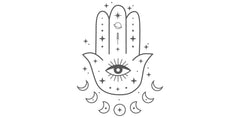
Found from Morocco to Mumbai.
Open hand. Five fingers. Often with eye in center.
Called:
- Hand of Fatima (Islamic)
- Hand of Miriam (Jewish)
- Khamsa (North Africa)
Stitched onto:
- Baby blankets
- Wedding veils
- Door curtains
- Market stall covers
Meaning: I am seen. I am blessed. I am safe.
Colors matter:
- 🔵 Blue = calm, divine protection
- 🔴 Red = life force, courage
- ⚪ White = purity, new beginnings
“The hand doesn’t push harm away. It holds space until harm forgets why it came.”
— Moroccan artisan
Colonialism Tried to Ban These Symbols. People Sewed Them Anyway.
Missionaries called them “witchcraft.”
Governments labeled them “backward.”
Schools punished children for wearing red threads or eye-stitched hems.
But the people?
They moved the symbols.
Inside collars. Under linings. Into sock cuffs.
Used muted threads. Whispered meanings.
Passed them down like heirlooms — hidden in plain sight.
Today?
- Turkish designers print nazar eyes on global streetwear — proudly reclaiming identity
- Navajo artists teach lightning stitches to youth — as acts of cultural survival
- Ukrainian grandmothers stitch extra rams’ horns on soldiers’ shirts — praying for safe return
- Berber women trademark diamond patterns — stopping fast fashion theft
- Wiccan covens revive sigil embroidery — as personal empowerment, not trend
“You can ban our cloth. But you can’t ban our protection.”
— Fatima-Zahra, Amazigh textile artist
How to Wear Protective Symbols — The Right Way
Yes, you can wear them.
But please — do it with care.
✅ DO:
- Learn what the symbol means first — its history, culture, context
- Buy from real artists — not Amazon, Shein, or Etsy resellers
- Ask if it’s sacred or restricted (some patterns aren’t for public wear)
- Credit the culture. Tag the maker. Say thank you.
- Wear it with respect — not as costume or trend
❌ DON’T:
- Buy cheap knockoffs with “evil eye” prints made in sweatshops
- Wear ceremonial items (like Navajo storm patterns or dreamcatchers) to music festivals
- Say “I’m obsessed with this tribe’s magic” without knowing their history
- Ignore requests from communities asking you not to use certain symbols
- Mass-produce sacred designs for profit without benefit-sharing
“Appreciation asks permission. Appropriation assumes power.”
— Dr. Adrienne Keene, Cherokee Nation, @nativeappropriations
Make Your Own Protective Symbol (Ethically!)
Want your own personal shield — rooted in nature, not stolen tradition?
Easy. Honest. Powerful.
Step 1: Walk Outside. Find Something That Feels Safe.
Look for:
- A stone that fits your palm
- A branch shaped like a shield
- A leaf with strong veins
- A shell that curves around itself
- A feather that landed near you
Pick one. Hold it. Thank it.
Step 2: Ask — What Does This Teach Me About Protection?
Is it hard? Soft? Curved? Sharp? Hollow? Full?
Write 3 words.
Example:
Pinecone → layered, patient, opens only when ready
Step 3: Turn It Into a Simple Repeatable Shape
Make it clean:
- Spiral for pinecone scales
- Zigzag for cracked bark
- Circle for smooth stone
- Triangle for mountain peak shadow
- Web for spider silk
Keep it abstract. Make it yours.
Step 4: Stitch, Paint, or Print It Somewhere Meaningful
On your journal. Your backpack. Your bedroom wall. Your shirt cuff.
Wear it or place it where you need protection most.
Say aloud: “This is my shield. Made by me. Blessed by earth.”
“The best protection isn’t taken — it’s grown.”
— Toko-pa Turner
Where to Buy Ethical Protective Folk Wear
| Culture | Ethical Source | What They Sell | Link |
|---|---|---|---|
| Turkish | Doku Art Istanbul | Hand-embroidered nazar wear | dokuart.ist |
| Navajo | Toadlena Trading Post | Lightning-pattern blankets | toadlenachapterhouse.com |
| Ukrainian | Vyshyvanka Day Project | Ram’s horn + triangle shirts | vyshyvankaday.org |
| Berber | Anou Cooperative | Diamond-eye wool capes | shopanou.com |
| Balkan | Marta’s Threads (Albania) | Black-embroidered vests | IG: @martasthreads.al |
| Ainu | Ainu Craft Store | River-zigzag ceremonial robes | ainu-craft.jp |
| Tibetan | Norbulingka Institute | Endless knot robes + aprons | norbulingka.org |
| Wiccan/Pagan | Spiral Goddess Studio | Hand-stitched pentacle wear | spiral-goddess.com |
| Norse-inspired | Heathen Crafts Co. | Vegvísir + rune-embroidered gear | heathencrafts.co |
| Egyptian Revival | Kemet Creations | Eye of Horus + scarab linen wear | kemetcreations.com |
⚠️ Avoid mass retailers. Support living artists directly.
Why This Matters More Than Ever
We live in anxious times.
Screens glare. News shouts. Algorithms feed fear.
Protective symbols in folk wear offer something radical:
Quiet strength. Rooted calm. Ancestral reassurance.
When you tie a red thread — you say: I choose life.
When you stitch a spiral — you say: I will not be broken.
When you wear an eye — you say: I am seen. I am held.
These symbols are not magic.
They are memory. Intention. Love made visible.
“Protection isn’t about hiding. It’s about standing — wrapped in wisdom.”
— Balkan elder
Your Turn: Shield Yourself. Honor Others. Stitch With Care.
You don’t need a museum robe to carry this power.
Start small. Start true.
👁️ 1. Pick One Symbol. Learn Its Roots.
Read a book. Watch a doc. Follow an artist.
📚 Try:
- The Evil Eye: A Casebook by Alan Dundes
- Braiding Sweetgrass by Robin Wall Kimmerer (for Indigenous worldview)
- Celtic Magic by D.J. Conway
- Northern Mysteries & Magick by Freya Aswynn (Norse)
- The Wicca Bible by Ann-Marie Gallagher
🧵 2. Support Real Artists
Buy direct. Pay fairly. Share their work.
Search: “[Culture] + protective textile artist + Instagram”
Follow: #FolkProtection #WearYourShield #AncestralArmor
✏️ 3. Make Your Own Symbol
Use the DIY steps above.
Name it. Bless it. Wear it proudly.
🗣️ 4. Speak Up
See stolen sacred symbols sold as “festival wear”? Gently correct.
See elders ignored? Amplify them.
See cultural erasure? Donate. Volunteer. Educate.
🌱 5. Give Back
Donate to Indigenous land-back funds.
Plant protective herbs (rosemary, sage, rue).
Clean local springs or rivers — water carries prayers.
Teach a child one protective symbol — and its true origin.
“Honor the hands that wove the first shields. Then weave your own.”
— Winona LaDuke
Final Thought: You’ve Always Been Protected
Next time you see an eye stitched on a cuff, a zigzag on a hem, a red thread tied at the wrist — pause.
That’s not “just decoration.”
That’s a mother’s midnight prayer.
A grandmother’s clever trick.
A rebel’s quiet resistance.
Protective symbols in folk wear are alive.
Wear them with love. Learn them with care. Pass them on — correctly.
And remember:
You, too, are being watched over.
By ancestors.
By earth.
By sky.
Stitch that truth into your days.
💌 Loved this? Share it with someone who needs shielding — gently, wisely, beautifully.
🧵 Follow #FolkProtection on Instagram.
✏️ Grab thread. Walk outside. Make your mark.
Written with deep respect for all who turned thread into talisman. May we wear their wisdom lightly, carry it deeply, and return it generously — to the hands, hearts, and lands that birthed it.

